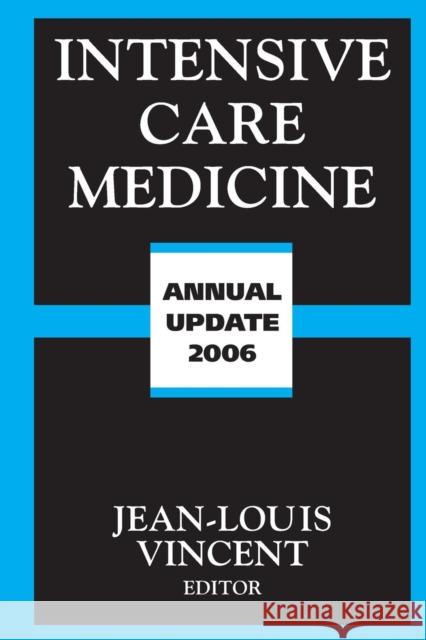Intensive Care Medicine: Annual Update 2006 » książka



Intensive Care Medicine: Annual Update 2006
ISBN-13: 9781493938759 / Angielski / Miękka / 2016 / 804 str.
Intensive Care Medicine: Annual Update 2006
ISBN-13: 9781493938759 / Angielski / Miękka / 2016 / 804 str.
(netto: 463,60 VAT: 5%)
Najniższa cena z 30 dni: 462,48
ok. 30 dni roboczych.
Darmowa dostawa!
Cellular Responses in Sepsis.- The Role of Toll-like Receptors in Sepsis.- The Emerging Role of RAGE in Sepsis.- Oxidative Stress in Sepsis: Implications on Liver Protein Patterns and Analysis via Modified Proteomics Technology.- HSP90: The Unsung Villain of Sepsis?.- The Role of Extracellular Heat Shock Proteins in Cellular Inflammation and Injury.- Quantitative in vivo Protein Synthesis as a Measure of Immune Function.- Fluid Resuscitation and Immunomodulation in the Critically III.- Cellular Dysfunction.- Mitochondrial Dysfunction and Critical Illness Myopathy.- Lactic Acidosis and Hyperlactatemia.- Cardiovascular Dysfunction.- Physiology and Pathophysiology of the Natriuretic Peptide System.- Heart Failure as a Co-Morbidity in the ICU.- The Vascular Bed during Critical Illness: Evaluation in Animal Models.- Hemodynamic Monitoring.- Intensive Care Echocardiography.- Intrathoracic Blood Volume: Clinical Applications.- Hemodynamic Management Guided by Esophageal Doppler.- Less Invasive Cardiac Output Monitoring: Characteristics and Limitations.- Pulse Pressure Analysis.- Pulse Pressure Variations in Managing Fluid Requirement: Beware the Pitfalls!.- Minimally Invasive Hemodynamic Monitoring Using the Pressure Recording Analytical Method.- Coagulopathies.- Thrombotic Microangiopathy Syndrome in the ICU.- Altered Functionality of von Willebrand Factor in Sepsis and Thrombocytopenia — Potential Role of the vWF Cleaving Protease ADAMTS-13.- Coagulopathy in the Critically Injured Patient.- Critical Bleeding in Blunt Trauma Patients.- Trauma: Bleeding, Coagulopathy, and Blood Component Transfusion.- Hemostatic Resuscitation.- Effects of Plasma Substitutes on Coagulation.- Blood Transfusions.- Transfusion as a Risk Factor for ALI and ARDS.- Red Blood Cell Desialylation in Critically III Patients: An Underestimated Cause of Anemia.- Cardiopulmonary Resuscitation.- Clinical Predictors of Physiological Deterioration and Subsequent Cardiorespiratory Arrest among Hospitalized Patients.- Cardiocerebral Resuscitation: A Better Approach to Out-of-Hospital Cardiac Arrest.- Induced Hypothermia for Neuroprotection: Understanding the Underlying Mechanisms.- Acute Lung Injury.- Hyaluronan in Acute Lung Injury.- Aspiration-induced Lung Injury: Experimental and Human Studies.- Pulmonary Edema in Organ Donors and Lung Transplant Recipients: Is there a Role for Beta-adrenergic Agonists?.- Respiratory Support.- Current Concepts of Airway Management in the ICU and the Emergency Department.- Use of Continuous Positive Airway Pressure in Critically III Patients.- Non-invasive Respiratory Support in Pre-term Neonates and Pediatric Patients with Respiratory Failure.- Fast and Slow Compliance: Time, in Addition to Pressure and Volume, is a Key Factor for Lung Mechanics.- Does Ventilator-induced Lung Injury Initiate Non-pulmonary Organ Dysfunction?.- Monitoring in Respiratory Failure.- Electrical Impedance Tomography and its Perspectives in Intensive Care Medicine.- Electrical Impedance Tomography for Monitoring of Regional Ventilation in Critically III Patients.- Volumetric Capnography for Monitoring Lung Function during Mechanical Ventilation.- Monitoring Respiratory Drive and Respiratory Muscle Unloading during Mechanical Ventilation.- Weaning from Mechanical Ventilation.- Weaning from Mechanical Ventilation.- Liberation from Mechanical Ventilation in Acutely Brain-injured Patients.- Non-invasive Ventilation for Respiratory Failure after Extubation.- Burn Injury.- Importance of Airway Management in Burn and Smoke Inhalation-induced Acute Lung Injury.- Metabolic Changes Following Major Burn Injury: How to Improve Outcome.- Antibiotic Dosing in Burn Injury: Should We be Looking at the Tissues more Closely?.- Metabolic Support.- Defining Relative Adrenal Insufficiency in the Critically III: The ACTH Test Revisited.- Enteral Nutrition in the Critically III: Should We Feed into the Small Bowel?.- Tight Energy Balance Control for Preventing Complications in the ICU.- Bacteriological Problems.- Acute Pneumonia and Importance of Atypical Bacteria.- Antibiodic Resistance in the Intensive Care Unit.- Fungal Infections.- Systemic Candida Infection in the ICU.- Candida Colonization Index in the Management of Critically III Patients.- Antifungal Therapy in Surgical ICU Patients.- Hepatosplanchnic Failure.- Splanchnic Perfusion and Oxygenation in Critical Illness.- Liver Failure: Diagnostic Assessment and Therapeutic Options.- Immunoparalysis in Liver Disease.- Hepatorenal Syndrome.- Renal Failure.- Sepsis and Acute Renal Failure.- Sixty Years of ‘Extended Dialysis’ in the ICU.- Anticoagulation in CRRT: Systemic or Regional?.- Plasma Filtration Adsorption Dialysis: A New Experimental Approach to Treatment of Sepsis and MOF.- Sleep and Delirium.- Sleep in the ICU.- Sleep and Delirium in the Critically III: Cause or Effect?.- Delirium, Recall and the Post-ICU Challenge.- Contemporary Issues.- Morbid Obesity as a Determinant of Outcome in the Critically III.- Patient Safety Management System in Pediatric ICUs.- Information Exchange in Intensive Care: How can we Improve?.- Catastrophic Anachronisms: The Past, Present and Future of Disaster Medicine.- Health Services Research and Critical Care.- Healthcare Disparities in Critically III Patients.- International Comparisons of Intensive Care: Understanding the Differences.
The Update compiles the most recent developments in experimental and clinical research and practice in one comprehensive reference book. The chapters are written by well recognized experts in the field of intensive care and emergency medicine. It is addressed to everyone involved in internal medicine, anesthesia, surgery, pediatrics, intensive care and emergency medicine.
1997-2026 DolnySlask.com Agencja Internetowa
KrainaKsiazek.PL - Księgarnia Internetowa









